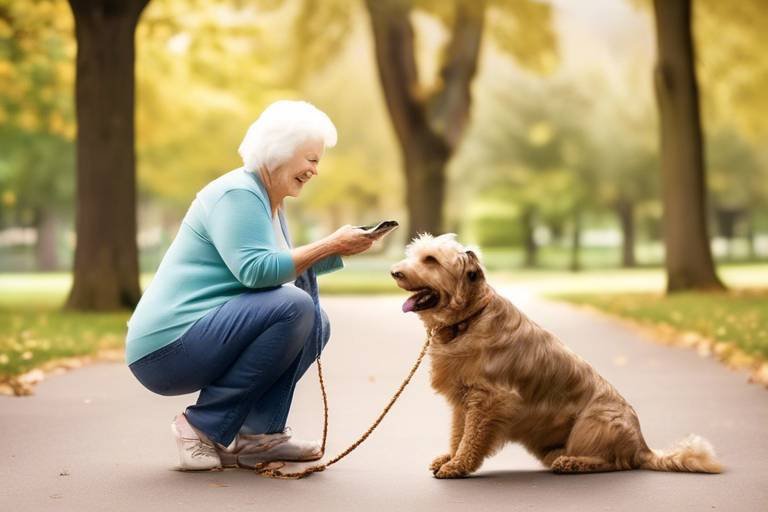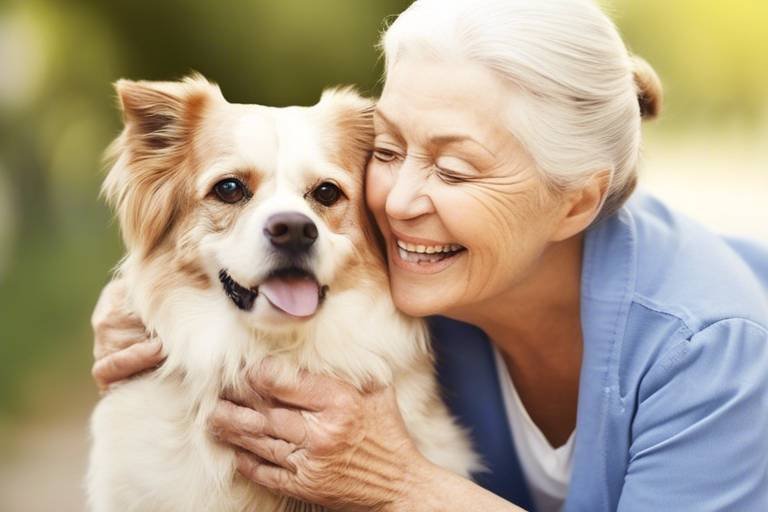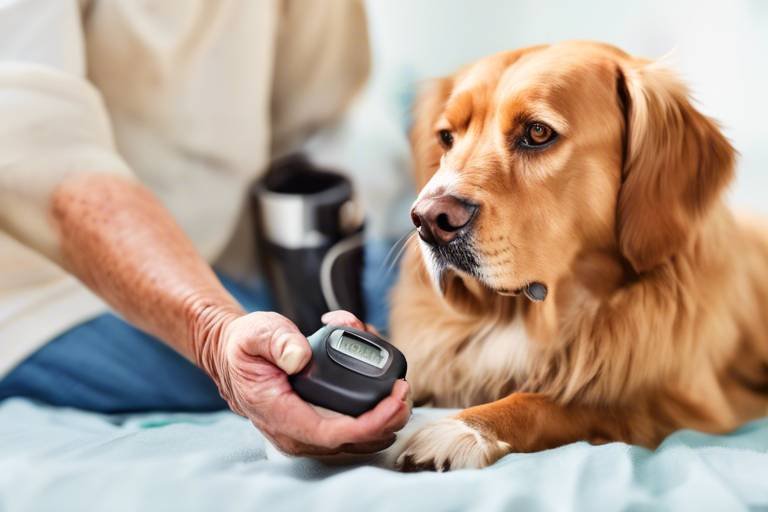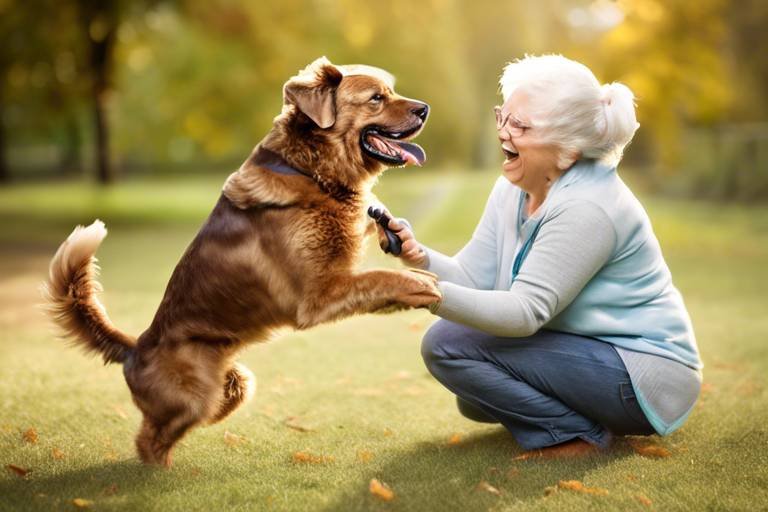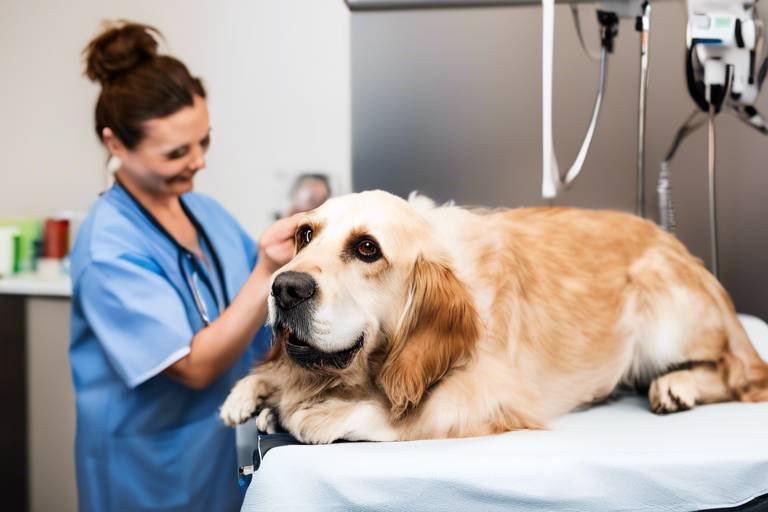The Benefits of Senior Pet-Friendly Activities
Engaging in activities with our senior pets is not just a pastime; it's a vital part of enhancing their quality of life. As our furry friends age, they experience changes that can affect their physical and mental well-being. By participating in pet-friendly activities, we can strengthen the bond we share with them, while also promoting their health and happiness. Have you ever noticed how a simple game of fetch or a leisurely stroll can light up your pet's eyes? It's these little moments that can transform their golden years into a joyful experience.
But why should we prioritize activities for our senior pets? The answer lies in the myriad of benefits that come with it. Engaging in fun and suitable activities can help combat the common issues faced by aging pets, such as loneliness, obesity, and reduced mobility. Imagine your pet, once full of energy, now spending most of their time lounging around. This shift can lead to a decline in their physical health and mental state. By introducing them to enjoyable activities, we can help them regain that spark and vitality.
Moreover, participating in activities together fosters a deeper connection between pets and their owners. This bond is essential, especially as pets age and may require more support and understanding. When we take the time to engage in activities that cater to their needs, we not only enhance their physical health but also create lasting memories. Think of it as a journey where every step taken together strengthens the love and trust shared between you and your pet.
In the following sections, we will explore various aspects of engaging in senior pet-friendly activities, from understanding their unique needs to creating a safe environment for them to thrive. Together, we can ensure that our beloved companions enjoy their twilight years filled with joy, love, and adventure.
- What are some safe activities for senior pets? Gentle exercises such as walking, swimming, and light play are ideal for senior pets, ensuring they stay active without overexertion.
- How can I tell if my senior pet is enjoying an activity? Look for signs of excitement, such as wagging tails, playful behavior, and a willingness to participate. If they seem tired or reluctant, it may be time to slow down.
- Are there specific gear recommendations for senior pets? Yes! Supportive gear like harnesses, ramps, and orthopedic beds can greatly enhance their comfort and safety during activities.
- How often should I engage my senior pet in activities? Regular, short sessions of activity are beneficial. Aim for several short walks or play sessions throughout the week, adjusting based on your pet's energy levels.

Understanding Senior Pets
When we talk about senior pets, we're referring to our furry companions who have gracefully aged, typically around the age of seven years for dogs and around ten years for cats. Just like humans, senior pets come with their own set of unique needs and characteristics that set them apart from their younger counterparts. Understanding these traits is crucial for pet owners who want to provide the best care possible. After all, our pets deserve comfort and happiness in their golden years!
One of the most significant changes that occur as pets age is the gradual decline in their physical abilities. Senior pets may experience reduced energy levels, joint stiffness, and even cognitive decline. This doesn't mean they can't enjoy life; it just means we need to be more mindful of their limitations. For instance, a once-energetic puppy may now prefer a cozy spot on the couch rather than a game of fetch. Recognizing these changes allows us to adapt our activities to suit their needs.
In addition to physical changes, senior pets often face health issues such as arthritis, dental problems, and vision or hearing impairments. These conditions can significantly affect their quality of life and the types of activities they can engage in. For example, a dog with arthritis may struggle with long walks, while a cat with dental issues might be less inclined to chew on their favorite toys. By understanding these challenges, we can tailor our approach to ensure our senior pets remain active and happy.
Moreover, the emotional well-being of senior pets is just as important as their physical health. Many senior pets experience feelings of loneliness or anxiety, especially if they have lost a companion or if their human family is busy. Engaging in activities together can help combat these feelings, providing not just physical stimulation but also much-needed social interaction. This connection strengthens the bond between pets and their owners, creating a nurturing environment where both can thrive.
To make it easier for pet owners to understand the essential characteristics of senior pets, here’s a quick overview:
| Characteristic | Details |
|---|---|
| Physical Changes | Reduced energy, joint stiffness, potential weight gain |
| Health Issues | Arthritis, dental problems, sensory impairments |
| Emotional Needs | Increased need for companionship and mental stimulation |
In summary, understanding the unique needs of senior pets is the first step toward providing them with the love and care they require. By being aware of their physical, health, and emotional changes, we can create a nurturing environment that allows them to enjoy their later years to the fullest. So let’s embrace this journey together and make the most out of every moment with our beloved senior pets!

Physical Benefits of Activities
Engaging in physical activities is not just a luxury for senior pets; it's a critical component of their overall health and well-being. Just like us, our furry friends need to stay active to maintain their vitality as they age. Regular exercise can help combat the effects of aging, keeping their bodies fit and their spirits high. Think of it as a way to keep their inner puppy alive, even when their bodies may not be as spry as they once were.
One of the most significant benefits of physical activity for senior pets is weight management. As pets age, their metabolism tends to slow down, which can lead to weight gain if their diet remains the same. This extra weight can exacerbate health issues such as arthritis or heart disease. By incorporating gentle exercises into their daily routine, pet owners can help their senior companions maintain a healthy weight, which is essential for a long, happy life.
Moreover, regular physical activity promotes improved mobility. Senior pets often experience stiffness and joint pain, which can limit their ability to move freely. Engaging in light exercises helps to keep their joints flexible and can even reduce pain levels over time. It's like giving them a gentle massage from the inside out! Activities such as walking or swimming can work wonders in keeping their bodies limber.
Here's a quick breakdown of the physical benefits:
| Benefit | Description |
|---|---|
| Weight Management | Helps prevent obesity and related health issues. |
| Improved Mobility | Enhances joint flexibility and reduces stiffness. |
| Increased Energy | Regular exercise can boost overall energy levels. |
| Better Heart Health | Cardiovascular exercise strengthens the heart. |
Additionally, engaging in physical activities can significantly enhance the overall physical health of senior pets. Just like humans, pets benefit from cardiovascular exercise, which strengthens their heart and lungs. This is crucial for maintaining their stamina and energy levels. Imagine how revitalizing it feels to take a brisk walk; your pet experiences the same joy and health benefits!
It's essential to remember that the type and intensity of exercise should be tailored to each pet's individual needs. For some, a leisurely stroll around the neighborhood might be perfect, while others may benefit from a gentle game of fetch in the backyard. The key is to listen to your pet and adjust activities according to their comfort level. This personalized approach not only keeps them engaged but also ensures they are not overexerted.
In conclusion, the physical benefits of activities for senior pets are numerous and vital. By incorporating a variety of gentle exercises into their routine, pet owners can help their furry friends maintain a healthy weight, improve mobility, and enhance their overall quality of life. Remember, every little bit counts, and the joy of movement can make a world of difference in your senior pet's golden years!
- What types of activities are best for senior pets? Gentle exercises such as walking, swimming, and light play are ideal.
- How often should I exercise my senior pet? Aim for short, frequent sessions several times a week, adjusting based on your pet's stamina.
- What should I do if my pet shows signs of discomfort during exercise? Stop the activity immediately and consult your veterinarian for advice.
- Can swimming be beneficial for all senior pets? Yes, swimming is a low-impact exercise that can be great for pets with joint issues.
Types of Suitable Exercises
When it comes to keeping our senior pets active, it's essential to choose gentle yet engaging exercises that cater to their unique needs. Think of these activities as a delightful stroll through a park on a sunny day—refreshing, invigorating, and just the right pace for our older companions. Here are some types of exercises that can keep your senior pets happy and healthy:
First up, we have walking. Short, leisurely walks are not only a fantastic way for your pet to stretch their legs but also an opportunity for them to explore the world around them. Imagine your furry friend sniffing the different scents, meeting other dogs, and enjoying the sights of nature. These walks can be tailored to their stamina, ensuring they don’t tire out too quickly. Consider using a comfortable harness to make the experience more enjoyable.
Next, let’s dive into swimming. This is a fantastic low-impact exercise that works wonders for senior pets, especially those with arthritis or joint issues. Swimming allows them to move freely without the strain that comes from walking or running. Just picture your pet splashing around in a calm pool or a gentle lake, enjoying the refreshing water while getting a great workout. It’s like a spa day that doubles as exercise!
Another great option is light play. This can include tossing a soft ball or engaging in gentle tug-of-war. The key is to keep it low-key and not too vigorous. You want to encourage movement without overwhelming them. Think of it as a friendly game of catch where the focus is more on fun than competition.
To ensure that your senior pet enjoys these activities, always pay attention to their cues. If they seem tired or reluctant, it’s perfectly fine to cut the session short. Remember, the goal is to keep them active and happy, not to push them beyond their limits. Here’s a quick overview of suitable exercises:
| Exercise Type | Description | Benefits |
|---|---|---|
| Walking | Short, leisurely walks in familiar surroundings | Stimulates senses, maintains mobility |
| Swimming | Gentle water play in a pool or calm lake | Low-impact exercise, good for joints |
| Light Play | Gentle games like fetch or tug-of-war | Encourages movement, promotes bonding |
In conclusion, engaging in these types of suitable exercises can greatly enhance your senior pet's quality of life. By keeping their activity level appropriate and enjoyable, you’re not just promoting their physical health—you’re also nurturing their mental well-being. So, lace up those walking shoes, fill up the pool, and get ready for some fun times with your furry friend!
Q: How often should I exercise my senior pet?
A: It varies based on your pet's health and mobility. Aim for short sessions several times a week, gradually increasing as they become more comfortable.
Q: What signs indicate my senior pet is overexerted?
A: Look for signs like excessive panting, reluctance to continue, or limping. Always prioritize their comfort and well-being.
Q: Are there specific breeds that require more exercise as seniors?
A: Yes, larger breeds may need more structured exercise to maintain their weight, while smaller breeds might require less intense activities. Always consult with your vet for personalized advice.
Walking and Hiking
When it comes to senior pets, can be a delightful adventure that offers both physical and mental stimulation. Imagine your furry friend, tail wagging with excitement, as they step outside into the fresh air, ready to explore the world around them! Short, leisurely walks not only provide essential exercise but also allow senior pets to experience new sights, sounds, and smells. These sensory experiences can be incredibly enriching, helping to keep their minds sharp and engaged.
It's important to remember that senior pets may not have the same energy levels or stamina as their younger counterparts. Therefore, tailoring the length and intensity of walks is crucial. Start with short distances and gradually increase the duration as your pet's comfort level grows. A good rule of thumb is to keep walks around 15-30 minutes, depending on your pet's mobility and health condition. Always keep an eye on them—if they seem tired or start lagging behind, it's a sign to take a break!
Moreover, the environment plays a significant role in the quality of your walks. Choose quiet, safe routes that are free from heavy traffic and loud noises. Parks with soft grass or trails with gentle inclines are ideal for senior pets. Not only do these settings provide a comfortable walking surface, but they also offer opportunities for your pet to sniff around and explore at their own pace. After all, every walk is not just about exercise; it’s about creating memories and enjoying the great outdoors together.
For those who love hiking, consider gentle trails that are suitable for senior pets. Look for paths that are well-maintained and not too steep. Carrying a small backpack with water and some treats can also be beneficial, ensuring your furry companion stays hydrated and energized. Remember, hiking can be a bonding experience, where you can both enjoy nature while strengthening your relationship. Just like us, senior pets thrive on quality time spent with their owners.
In conclusion, walking and hiking are not just activities; they are opportunities to enhance your senior pet's life. By ensuring that these outings are safe, enjoyable, and tailored to your pet's needs, you can create a rewarding routine that keeps both of you happy and healthy. So grab that leash, put on those walking shoes, and get ready for some fun adventures together!
- How often should I take my senior pet for walks? Aim for short walks 3-5 times a week, adjusting based on your pet's energy levels and health.
- What should I bring on a hike with my senior pet? Always carry water, some treats, and a first-aid kit. A comfortable harness can also be helpful.
- Can I take my senior pet on longer hikes? Only if they are physically capable. Start with shorter hikes and gradually increase the distance.
- What signs should I watch for during walks? Look for signs of fatigue, such as lagging behind, heavy panting, or reluctance to continue.
Swimming and Water Play
Swimming and water play are not just fun activities; they can be a game changer for senior pets, especially those dealing with joint issues like arthritis. The buoyancy of water allows them to exercise without the harsh impact that comes from traditional activities. Imagine your furry friend gliding through the water, free from the weight of their body, and feeling the refreshing coolness around them. It's like a spa day, but for pets!
When introducing your senior pet to swimming, it's essential to start slowly. Not all pets are natural swimmers, so consider using a life vest designed for dogs to ensure their safety. You wouldn't throw a child into the deep end without a floatie, right? The same principle applies here. You want to build their confidence and comfort level in the water. Begin in shallow areas where they can stand and gradually move to deeper sections as they become more at ease.
Water play can take many forms, from gentle splashing in a kiddie pool to swimming in a calm lake or ocean. Here are some engaging water activities you might consider:
- Fetch in the Water: Use a floating toy to encourage your pet to retrieve it. This not only provides exercise but also stimulates their mind.
- Water Obstacle Course: Set up a simple course using floating objects or toys. This can keep them engaged and active.
- Gentle Splashing: Sometimes, just letting them wade around and splash can be incredibly enjoyable and beneficial.
It's also important to monitor your pet closely during these activities. Keep an eye on their energy levels and ensure they don’t overexert themselves. Remember, the goal is to have fun while promoting their physical health. After swimming, be sure to dry them off properly, especially around their ears, to prevent any infections.
In conclusion, swimming and water play can be an excellent way to keep your senior pet active and happy. Not only does it provide a fantastic outlet for physical exercise, but it also allows for quality bonding time between you and your furry friend. So, grab that life vest and let the splashing begin!
Social Interaction and Mental Stimulation
When it comes to our furry friends, especially senior pets, social interaction and mental stimulation are key ingredients for a happy and fulfilling life. Just like humans, pets thrive on companionship and engagement. Imagine being cooped up at home all day without anyone to talk to or any activities to keep your mind busy—it’s not much fun, right? Senior pets often face loneliness and boredom, which can lead to anxiety and behavioral issues. That's why integrating social activities into their routine is essential.
Engaging in social activities not only combats these feelings but also enhances their overall well-being. Think of it as a mental workout! Activities like visiting a pet-friendly park, participating in group training sessions, or even just having playdates with other pets can provide the necessary stimulation. These interactions can reignite their playful spirit, making them feel young again. Plus, they get to explore new environments, which can be incredibly enriching for their minds.
Here are some fun ideas to boost your senior pet's social life:
- Playdates: Organize get-togethers with other pets. This can be a great way for your pet to socialize and enjoy the company of their peers.
- Pet Classes: Look for classes designed for older pets that focus on gentle training techniques. This not only provides mental stimulation but also strengthens the bond between you and your pet.
- Community Events: Attend local pet-friendly events or festivals. It’s a fantastic way for your pet to meet new friends and experience new sights and sounds.
Additionally, incorporating puzzle toys or interactive games can stimulate their minds at home. These activities encourage problem-solving and keep their brains sharp. For instance, you can hide treats in a puzzle feeder or use toys that require them to figure out how to get to a reward. These simple yet effective activities can significantly enhance their cognitive functions while providing a sense of accomplishment.
In summary, fostering social interaction and mental stimulation in senior pets is not just about keeping them entertained; it’s about enriching their lives and ensuring they remain happy and healthy. So, get out there and create wonderful memories with your furry companion—because every wag of their tail is a testament to the joy you bring into their lives!
- What are some signs that my senior pet needs more social interaction? Look for signs of boredom, such as destructive behavior, excessive barking, or lethargy. If your pet seems less active or engaged, it may be time to introduce more social activities.
- Can I take my senior pet to dog parks? Yes, but ensure that the environment is safe and that other dogs are friendly. Start with short visits to gauge your pet's comfort level.
- How can I tell if my pet enjoys an activity? Pay attention to their body language. A happy pet will wag their tail, have a relaxed posture, and show enthusiasm. If they seem anxious or withdrawn, it might be best to try something else.

Creating a Safe Environment
When it comes to engaging in activities with our beloved senior pets, is paramount. As our furry friends age, they often face various challenges, including mobility issues and decreased energy levels. Therefore, it's essential to tailor their surroundings to ensure maximum comfort and security. Imagine stepping into a space where every corner is designed with your pet's needs in mind—this not only enhances their experience but also allows you to enjoy your time together without worry.
First and foremost, consider their mobility limitations. Senior pets may struggle with stairs, slippery floors, or uneven surfaces. To combat this, you can make simple adjustments, such as:
- Covering slippery floors with non-slip rugs or mats.
- Using ramps for easy access to cars or furniture.
- Creating a designated area for play that is free from obstacles.
Another critical aspect of a safe environment is minimizing hazards. Just as we baby-proof our homes for toddlers, we should also pet-proof our spaces for senior pets. This means:
- Removing toxic plants or chemicals that could pose a risk.
- Securing electrical cords to prevent tripping.
- Ensuring that small objects or choking hazards are out of reach.
Furthermore, consider the temperature of your home. Senior pets can be particularly sensitive to extreme heat or cold. Make sure they have a cozy, warm spot to rest, especially during colder months, and provide plenty of fresh water to keep them hydrated during hot days. You might even want to invest in a pet-friendly heating pad or cooling mat to help them regulate their body temperature comfortably.
Lastly, don't forget about supervision. While it’s essential to give your senior pet space to explore and enjoy their surroundings, keeping a close eye on them during activities can prevent accidents and ensure their safety. Think of yourself as a watchful guardian, ready to step in if they need assistance or if something seems amiss.
In conclusion, a safe environment enriches the experience for both you and your senior pet. By making thoughtful adjustments and being proactive in your approach, you can create a haven where your furry friend feels secure and loved. This not only enhances their quality of life but also strengthens the bond you share, making every moment spent together a cherished memory.
- What are some common signs that my senior pet needs a safer environment?
Look for signs of hesitation when navigating stairs, difficulty getting up from resting positions, or signs of anxiety in certain areas of your home. - How can I tell if my pet is too hot or too cold?
Watch for excessive panting, lethargy, or shivering. If they seem uncomfortable, it's time to adjust their environment. - Are there specific products recommended for senior pet safety?
Yes! Consider investing in non-slip mats, ramps, pet gates, and orthopedic beds to enhance comfort and safety.
Adapting Activities for Mobility Issues
When it comes to our beloved senior pets, adapting activities to suit their mobility issues is not just beneficial; it's essential. Imagine your furry friend struggling to keep up during a game of fetch or feeling left out while others frolic around. To ensure they can still enjoy their time with you, it's crucial to tailor activities to their unique needs. By doing so, you not only enhance their quality of life but also make sure they feel included and cherished.
One effective way to adapt activities is by incorporating shorter durations and gentler movements. Instead of an intense run in the park, consider a leisurely stroll around the block. This not only reduces the strain on their joints but also allows them to explore their surroundings at a comfortable pace. Additionally, using positive reinforcement can make these adapted activities more enjoyable. A few treats or a favorite toy can motivate your senior pet to participate without feeling overwhelmed.
Another approach is to utilize supportive gear designed specifically for pets with mobility challenges. Items like harnesses can provide extra support, while pet ramps can help them navigate obstacles like stairs or vehicles with ease. This equipment not only encourages participation but also ensures their safety. It’s like giving them a helping hand as they embark on their little adventures!
Moreover, consider indoor activities when outdoor conditions aren’t favorable. Engaging in gentle play sessions using soft toys or interactive games can stimulate their minds while keeping them physically active. For example, hiding treats around the house can turn a simple scavenger hunt into an exciting challenge, keeping their spirits high and their minds sharp.
Ultimately, the goal is to create an environment where your senior pet feels comfortable and happy. By observing their behavior and being attuned to their needs, you can modify activities accordingly. Always remember, it's not about how much they can do, but rather how much joy you can bring into their lives together. After all, these moments of connection are what truly matter.
- What types of activities are best for senior pets with mobility issues?
Gentle activities like short walks, swimming, or interactive indoor games are ideal. Always tailor the activities to their comfort level.
- How can I make my home more accessible for my senior pet?
Consider using ramps, non-slip mats, and keeping food and water bowls at an easily reachable height to ensure their comfort.
- Should I consult a vet before starting new activities with my senior pet?
Yes, it's always a good idea to consult your veterinarian to ensure that the activities you choose are safe and suitable for your pet's specific health conditions.
Using Supportive Gear
When it comes to ensuring that our senior pets remain active and engaged, utilizing supportive gear can make a world of difference. Just like we might use a walking cane or a knee brace as we age, our furry friends can benefit from various tools designed to enhance their mobility and comfort. This gear not only helps them participate in activities but also gives pet owners peace of mind knowing that their pets are safe and supported.
One of the most popular items is the harness. Unlike traditional collars, which can put pressure on a pet's neck, a well-fitted harness distributes weight evenly across the body. This is especially important for senior pets who may have neck or spinal issues. A harness allows for better control during walks and can prevent any sudden pulling that might lead to injury. Many harnesses even come with additional padding, which provides extra comfort for our older companions.
Another essential supportive tool is the ramp. As pets age, jumping into the car or onto the couch can become a daunting task. A ramp provides a gentle slope that allows them to access their favorite spots without straining their joints. This is particularly beneficial for larger breeds or those with arthritis, as it minimizes the risk of injury while still allowing them to enjoy their surroundings. When selecting a ramp, look for one that is sturdy, has a non-slip surface, and is the right height for your pet's needs.
For pets that require additional assistance, slings or supportive vests can also be invaluable. These items can help lift and support a pet's weight, making it easier for them to move around the house or during outings. Whether your pet is recovering from surgery or simply needs a little extra help due to aging, these tools can enhance their mobility and encourage them to stay active.
In addition to these supportive items, it’s crucial to create a safe environment for your senior pets. This means removing any obstacles that could cause them to trip and ensuring that their living space is easy to navigate. By combining supportive gear with a safe environment, you can significantly improve your senior pet's quality of life.
Ultimately, using supportive gear is about enhancing the experience for both pets and their owners. It allows for more freedom and enjoyment in activities, fostering a deeper bond between you and your furry friend. So, don’t hesitate to invest in the right gear that can help your senior pet thrive!
- What type of harness is best for senior pets? Look for a harness that is padded, adjustable, and designed to distribute weight evenly. A front-clip harness can also help prevent pulling.
- How do I choose the right ramp for my pet? Measure the height your pet needs to reach and select a ramp that is sturdy, has a non-slip surface, and is appropriate for your pet's size and weight.
- Are there any specific slings recommended for senior pets? Yes, look for slings that are adjustable, padded, and easy to use. They should provide support without causing discomfort.
- How can I encourage my senior pet to use supportive gear? Introduce the gear slowly, using positive reinforcement and treats to create a positive association. Make sure they see it as a tool for fun and adventure.

Bonding Through Activities
Participating in activities with your senior pet is more than just a way to keep them active; it’s a beautiful opportunity to strengthen the bond between you and your furry friend. Think of it as a dance where both partners are learning to move together gracefully, each step bringing you closer. When you engage in shared experiences, you create lasting memories that enrich your relationship and enhance your pet's quality of life.
Quality time spent together can lead to a deeper understanding of your pet's needs and preferences. Just like humans, pets have unique personalities, and engaging in activities allows you to discover what makes them tick. For instance, some senior pets may love the thrill of gentle play, while others might prefer the calmness of a cozy cuddle session. By observing their reactions during various activities, you can tailor your interactions to what they enjoy the most, creating a more fulfilling experience for both of you.
Moreover, celebrating special moments through activities can turn ordinary days into extraordinary ones. Whether it’s a simple stroll in the park or a fun water play session, each activity can become a celebration of life. These experiences can highlight the unique quirks and personalities of your senior pets, making their later years filled with joy and love. Imagine throwing a mini birthday party for your senior dog, complete with treats, games, and their favorite toys. Not only does it make them feel special, but it also deepens your connection as you share laughter and joy together.
To maximize the bonding experience, consider incorporating a variety of activities that cater to both of your interests. Here are a few ideas:
- Interactive Games: Engage in gentle games of fetch or hide-and-seek. These activities stimulate their minds and foster interaction.
- Nature Outings: Explore new trails together, allowing your pet to experience different scents and sights, enhancing their curiosity.
- Training Sessions: Teach your senior pet new tricks or commands. This not only keeps their mind sharp but also reinforces your bond through positive reinforcement.
In conclusion, the time spent engaging in activities with your senior pet is invaluable. It’s a journey filled with love, laughter, and learning. As you embark on this adventure together, you’ll find that each moment strengthens the trust and companionship between you and your beloved pet, making every day a little brighter.
Q: What types of activities are best for senior pets?
A: Gentle activities such as short walks, swimming, and interactive games are ideal. Tailor these activities to your pet's capabilities to ensure they enjoy themselves without overexertion.
Q: How can I tell if my senior pet is enjoying an activity?
A: Look for signs of enthusiasm, such as wagging tails, playful behavior, or a willingness to engage. If they seem tired or reluctant, it may be time to slow down or change the activity.
Q: Should I consult a vet before starting new activities with my senior pet?
A: Yes, it's always a good idea to consult with your veterinarian before introducing new activities, especially if your pet has existing health issues or mobility concerns.
Quality Time and Connection
Engaging in activities with your senior pet is not just about keeping them active; it’s about creating lasting memories and deepening the bond you share. Think of it as a beautiful dance where both partners need to be in sync. When you take the time to engage in enjoyable activities, you’re not only providing physical stimulation for your furry friend, but you’re also tapping into their emotional well-being. Have you ever noticed how a simple game of fetch can turn into a joyful reunion of sorts? That wagging tail and those excited barks are a testament to the happiness that comes from shared experiences.
Quality time spent together allows you to observe your pet’s unique personality traits and preferences. For instance, some senior dogs may prefer a leisurely stroll in the park, while others might find joy in a cozy cuddle session on the couch. By paying attention to these nuances, you can tailor activities that resonate with their individual needs, making your time together even more meaningful.
Moreover, engaging in these activities fosters a sense of trust and companionship. It’s like building a bridge that connects your hearts. When your pet sees you making an effort to include them in fun activities, they feel loved and valued. This connection can significantly reduce anxiety and behavioral issues, as they sense your presence and support. Remember, the joy is not just in the activity itself but in the shared moments that make your bond unbreakable.
Here are a few ways to maximize quality time with your senior pet:
- Be Present: Put away distractions like your phone or TV. Focus on your pet and the activity at hand.
- Explore New Places: Take short trips to new parks or pet-friendly cafes. New environments can stimulate their senses and keep things exciting.
- Learn Together: Consider training sessions that focus on gentle commands or tricks. It’s a fun way to engage their minds and strengthen your bond.
Ultimately, the time you invest in these activities is an investment in your pet’s happiness and your relationship. It’s about cherishing those golden moments that make life with a senior pet so special. So, grab that leash, fill up the water bowl, and create some unforgettable memories together!
Q: What are some easy activities to do with my senior pet?
A: Gentle walks, swimming, or even simple indoor games like hide and seek can be great options. Always consider their physical capabilities.
Q: How can I tell if my senior pet is enjoying an activity?
A: Look for signs of excitement, like wagging tails, playful barks, or a relaxed demeanor. If they seem tired or disinterested, it might be time to take a break.
Q: Are there any safety tips I should follow for senior pet activities?
A: Yes! Ensure the area is safe and free of hazards. Use supportive gear if needed, and always monitor your pet for signs of fatigue or discomfort.
Q: How often should I engage in activities with my senior pet?
A: Aim for short, frequent sessions throughout the week. The key is consistency, so even 10-15 minutes a day can make a big difference.
Celebrating Special Moments
Every pet has its own unique personality, and as they age, it's essential to celebrate the special moments that define their lives. Creating memorable experiences for senior pets not only brings joy to their days but also strengthens the bond between you and your furry friend. Think of it as a beautiful tapestry woven from the threads of love, laughter, and shared adventures. As your pet grows older, these moments become even more precious, reminding you of the joy they have brought into your life.
One way to celebrate is by planning special outings that cater to their interests and physical abilities. Whether it’s a leisurely stroll in the park, a cozy picnic in the backyard, or even a short road trip to their favorite spot, these activities can reignite their zest for life. Imagine their excitement as they sniff the fresh air or feel the grass under their paws, and you’ll realize how much these experiences mean to them.
Additionally, consider hosting a birthday party or a “gotcha day” celebration, where you can invite friends and their pets. This not only provides a fun socialization opportunity for your senior pet but also allows you to share your love with others who understand the joys and challenges of pet parenthood. You can prepare special treats, create a pet-friendly cake, and capture these moments with photographs to cherish forever.
Here are some ideas for celebrating special moments with your senior pet:
- Memory Scrapbook: Create a scrapbook filled with photos and memories of your time together. This can be a heartwarming project that you can revisit often.
- Personalized Gifts: Consider getting them a custom collar, a cozy blanket, or even a portrait that captures their essence.
- Favorite Treats: Spoil them with their favorite treats or a special meal. After all, who doesn’t love a culinary delight?
Remember, celebrating these moments doesn’t always have to be extravagant. Sometimes, the simplest things, like cuddling on the couch or enjoying a sunny afternoon together, can be the most meaningful. These small gestures of love contribute to a fulfilling life for your pet, making them feel cherished and valued.
In conclusion, as you embark on this journey of celebrating special moments with your senior pet, keep in mind that it’s all about creating lasting memories. The joy and love you share will undoubtedly enrich both your lives, making their golden years truly special.
Q: How can I tell if my senior pet is enjoying the activities?
A: Look for signs of happiness, such as wagging tails, playful behavior, and relaxed body language. If they seem engaged and excited, they are likely enjoying the activity.
Q: Are there any activities I should avoid with senior pets?
A: Avoid high-impact activities that can strain their joints, such as jumping or running on hard surfaces. Always consult your veterinarian if you're unsure about the suitability of an activity.
Q: How can I make my home more pet-friendly for my senior dog or cat?
A: Ensure that your home is free of hazards, provide comfortable resting areas, and consider using ramps or non-slip mats to help them navigate safely.

Conclusion: Embracing the Journey
Engaging in senior pet-friendly activities is not just a pastime; it’s a rewarding journey that enriches the lives of both pets and their owners. As we navigate through the golden years of our beloved companions, it becomes essential to recognize the profound impact that shared experiences can have on their well-being. By participating in activities tailored to their unique needs, we not only enhance their quality of life but also strengthen the bond we share. Imagine the joy on your pet's face during a gentle walk in the park or the excitement they show when splashing around in water. These moments are priceless!
Moreover, it’s important to remember that every interaction counts. Whether it's a simple game of fetch in the backyard or a cozy cuddle session on the couch, each activity fosters a deeper connection between you and your furry friend. This connection is built on trust, love, and understanding, allowing you to better appreciate your pet's quirks and preferences. As you embark on this journey together, you’ll find that the joy of creating special memories will outweigh any challenges that come your way.
To ensure that your senior pet enjoys their activities to the fullest, consider the following:
- Listen to Their Needs: Pay attention to how your pet responds to different activities. Modify them as needed to keep them comfortable and engaged.
- Celebrate Their Uniqueness: Each senior pet has its own personality. Embrace these traits and incorporate them into your activity plans.
- Stay Patient: It’s important to be patient and understanding of their limitations. This patience will lead to a more enjoyable experience for both of you.
In conclusion, embracing the journey of engaging in activities with your senior pet is about more than just physical exercise; it’s about creating a legacy of love and companionship. By prioritizing their needs and fostering a safe, stimulating environment, you’re ensuring that their later years are filled with happiness and adventure. So, lace up those walking shoes, grab that floatie, and get ready to create some unforgettable memories with your cherished companion!
Here are some common questions pet owners have about engaging in activities with senior pets:
- What types of activities are best for senior pets? Gentle exercises like walking, swimming, and light play are ideal. Always consider your pet's individual capabilities.
- How can I tell if my senior pet is overexerting themselves? Watch for signs of fatigue, such as excessive panting or reluctance to continue. Always prioritize their comfort.
- Is it necessary to adapt activities as my pet ages? Absolutely! Adjusting activities to accommodate their mobility and health limitations is crucial for their safety and enjoyment.
- Can socialization activities benefit my senior pet? Yes! Socialization helps combat loneliness and boredom, enhancing their mental well-being.
Frequently Asked Questions
- What are some signs that my pet is becoming a senior?
As pets age, they may exhibit various signs such as decreased energy levels, changes in appetite, weight fluctuations, and mobility issues. You might also notice increased sleeping or difficulty in jumping and climbing. Being aware of these signs can help you provide better care for your senior pet.
- How often should I engage my senior pet in physical activities?
It's essential to strike a balance. Aim for short, gentle activities several times a week. Depending on your pet's health and stamina, you might start with 10-15 minute sessions and gradually increase as they become more comfortable. Always consult your veterinarian to tailor an activity plan that suits your pet's specific needs.
- Are there specific exercises recommended for senior pets?
Absolutely! Gentle exercises like short walks, swimming, and light play are excellent options. Activities should be adapted to your pet's physical capabilities to ensure they remain safe and enjoy themselves. Remember, the goal is to keep them active without overexerting them.
- How can I ensure my senior pet is safe during activities?
Creating a safe environment is crucial. Remove any hazards that could cause falls or injuries, and consider using supportive gear like harnesses or ramps. Always supervise your pet during activities and adjust the intensity based on their comfort level.
- What are some fun activities to do with my senior pet?
There are plenty of enjoyable activities! You can take leisurely walks, enjoy some water play, or even engage in simple games that stimulate their mind. The key is to focus on activities that your pet enjoys and can comfortably participate in.
- How can activities help strengthen the bond with my senior pet?
Engaging in activities together fosters trust and companionship. It allows you to understand your pet's preferences better and creates cherished memories. Spending quality time together can deepen your connection and enhance your pet's happiness.
- Can I celebrate special moments with my senior pet?
Definitely! Celebrating special moments can be as simple as a favorite treat, a fun day out, or a cozy cuddle session. These experiences not only bring joy to your pet but also create lasting memories that you both can cherish.

